BUCKYBALLS
HEPA filters may also be effective in capturing ‘buckyballs,’ geodesic dome-shaped structures which is spherical with multiple flat sides. Strong evidence suggests that these hearty radioactive Uranium-60 nanoparticles have spanned the Pacific quickly with their concentrations rising.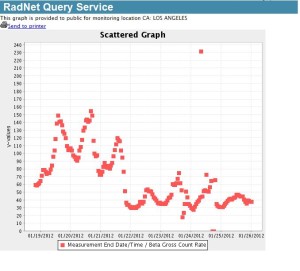
That evidence includes Radiation Station – Santa Monica’s hot HEPA filter readings and the EPA’s high beta readings in Los Angeles. Our radiation station is a little over a mile from the Pacific shoreline. Downtown Los Angeles is over 13 miles away from the sea.
The January 27, 2012 U.C. Davis report, “Uranyl peroxide enhanced nuclear fuel corrosion in seawater,” is the first account to analyze what is happening to the gargantuan amount of seawater, as well as fresh water, that has been hosing down the melted reactor cores and flushing into the Pacific.
The study’s abstract spells out a horrific scenario:
“The Fukushima-Daiichi nuclear accident brought together compromised irradiated fuel and large amounts of seawater in a high radiation field. Based on newly acquired thermochemical data for a series of uranyl peroxide compounds containing charge-balancing alkali cations, here we show that nanoscale cage clusters containing as many as 60 uranyl ions, bonded through peroxide and hydroxide bridges, are likely to form in solution or as precipitates under such conditions. These species will enhance the corrosion of the damaged fuel and, being thermodynamically stable and kinetically persistent in the absence of peroxide, they can potentially transport uranium over long distances.”
The majority of the fuel matrix at the Fukushima reactor complex is made up of uranium-oxide “whose behavior will largely dictate release of matrix-incorporated plutonium and various other radionuclides into water used as a coolant,” according to a full copy of the report obtained from one of the study’s authors, Dr. Alexandra Navrotsky.
Navrotsky is the director of U.C. Davis’ Nanomaterials in the Environment, Agriculture, and Technology Organized Research Unit and the recipient of many honors since becoming a PhD at the University of Chicago in 1967. Those honors include becoming an Alfred P. Sloan Fellow in 1973 and Best University Paper Award, Department of Energy Geoscience Grantee Meeting in 2009.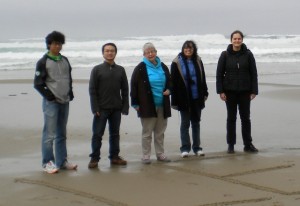
The report was a joint project of U.C. Davis, Sandia National Laboratories Department of Civil Engineering and Geological Sciences, the University of Notre Dame and its Department of Chemistry and Biochemistry. It appeared in the January 23, 2012 Proceedings of the National Academy of Science journal.
This level of expertise and resources is crucial for understanding the full breadth of the problem buckyballs pose. No other peer-reviewed study of Fukushima fuel metamorphosis and mobility capabilities yet exists.
The team of scientists found that water-soluble U60 buckyballs were created when water was spray directly onto the Fukushima fuel, at first fresh water then seawater along with fresh water. The intense radiation produced when the water hits the gooey ‘corium’ creates peroxide.
The places where the peroxide is the greatest – in the spent fuel cooling pools, stagnant ponds and where the water hits the fuel – “simple uranyl peroxide species, as well as complex nanoscale cage clusters built from uranyl peroxide polyhedra, will form in these environments.”
These U60 nano-cages of uranium not only can move fast through water, they last a long time according to the report persisting for “at least 294 days without detectable change.”
Not only does the seawater turn into peroxide-creating buckyball soup, the salt water corrodes the melted nuclear fuel stripping it of the most dangerous radionuclides on Earth which end up in the ocean, a process that has gone on unabated for nearly a year.
Buckyballs don’t need peroxide to continue to persist, according to the study, and can spread to exist in seawater out of the peroxide zone, dissolving or existing as nanoscale radioactive time bombs that will have the capability infuse the marine food chain.
How hot these nano-cage clusters of cancer-causing radiation are depends on what kind and ratio of uranium isotopes make up the 60 in each one. “A given isotope has the same radioactivity (half-life) regardless of what chemical state it is in,” Dr. Navrotsky told EnviroReporter.com in a January 28 email exchange. “So the radioactivity for a constant number of U atoms depends on the proportion of different isotopes in the sample, not on whether U is tetravalent or hexavalent (or the metal).”
“Reactor fuel is a tailored mixture of them,” she continued, explaining that the buckyball phenomena would affect and ‘cage’ each uranium isotope. “They all behave the same chemically, so yes to all of them. Remember that fission and radioactivity are controlled by properties of the nucleus (protons and neutrons) while chemistry is controlled by the electrons. So the chemistry of all the U isotopes is essentially the same.”
Naturally the reaction to news of hot Fukushima buckyballs was strong in the community of “raddies” that follow Fukushima meltdown developments.
“These people here I believe deserve an award for thinking of these possibilities and doing these tests,” said Potrblog in the January 28 post Weaponized Fukushima Fallout: Radioactive Fullerenes and Endofullerenes. “As people look back 50 years from now on the cancer rates and the deaths associated with Fukushima, this study here will probably be the key indicator in a significant quantity of those cancers and deaths.”
“People don’t realize how bad this news is and it’s likely to be underreported how bad of a news this is but if you’re a reporter in Fukushima or you’re anywhere around Fukushima, and you’re going to rely on an N-95 or a surgical mask to keep you safe, you’re hosed,” continued Potrblog. “This type of contaminant requires at least a P-100 respirator if not a self-contained breathing apparatus.”
PACIFIC PESTILENCE
There is a strong possibility that these uranium peroxide buckeyballs are already sloshing around in the waters off of Southern California as our HEPA air filters appear to indicate.
It has been nearly a year since this disaster started, the only kind of disaster that gets worse as time goes on. Fukushima is no exception with the extreme temperature spikes and Unit 4’s spent fuel cooling pool potential to topple to the ground if and when the leaning building collapses.
If uranium-filled buckyballs, and perhaps other radionuclides, are offshore here and elsewhere on the Pacific Rim where high radiation of the sort we’ve sampled comes from ambient air not radon or precipitation, how do they get to our HEPA filter?
One strong possibility may be ominous for the 40% of humanity that live within 100 kilometers of a marine ecosystem according to the United Nations Environment Programme.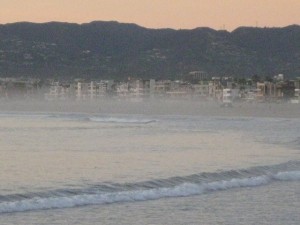
Sea spray.
Radioactive sea spray has been shown to blow hundreds of kilometers inland in tests conducted in the United Kingdom by British and European researchers. As one who has ever smelled the salty ocean air miles from the ocean might expect, salt in sea spray can travel a significant distance though it is far larger than what water molecules that it will precipitate around it before remobilization. The same holds true for radioactive particles floating in the sea even if it they aren’t of the U60 buckyballs variety.
In the 2008 report “Sea to land transfer of radionuclides in Cumbria and North Wales: updating of previous investigations” by the Westlakes Scientific Consulting Ltd., of Cumbria, United Kingdom, researchers looked at the inland deposition trends at Nethertown, a burgeoning hamlet 10 kilometers north of the highly contaminated nuclear reprocessing site Sellafield which sits on the east coast of the Irish Sea.
Sellafield was picked as a plutonium production plant by the British government in 1947 for nuclear weapons and before long a nuclear reactor site called Windscale Piles was constructed. For half a century, beginning in 1950, the place has been plagued by nuclear accidents. A fire destroyed the core of Pile 1 on October 1, 1957 releasing an estimated 750 terabecquerels (20,000 curies) into the environment. The goo included 22 TBq of cesium-137 and 740 TBq of Iodine-131.
Until the Fukushima disaster, the Irish Sea was considered to be the most radioactively contaminated marine body of water in the world. One of the reasons, activists say, is that in the 1940’s and 1950s, a pipe carrying diluted radioactive waste out to sea pumped millions of gallons of hot goo into the once pristine waters.
The Convention for the Protection of the Marine Environment of the North-East Atlantic reported in 2000 that an estimated 200 kilograms of plutonium had been dumped and pumped into the Irish Sea and ended up deposited in its marine sediments. Fish and cattle in the sea and around it were found to be contaminated by plutonium-239 and cesium-137 according to the study.
The Westlakes investigation found that the greatest average concentration of Cs-137 and Pu-239 in soil at a depth of 0 to 15 centimeters was 10 kilometers from the coast. The highest average amounts found at 15 to 30 cm deep were 5 km away from the sea.
A 62-page UK study released in December 2011 by the Manchester-based Nuclear Free Local Authorities (NFLA) is one of the most comprehensive analyses of the radiation problems plaguing the water body between the United Kingdom and Ireland.
The government-affiliated citizen activist group has been in existence for 31 years. Knowledge of the Irish Sea and its surrounding communities, combined with sharp science paints a picture of an americium, cesium and plutonium-filled sea that is not pretty.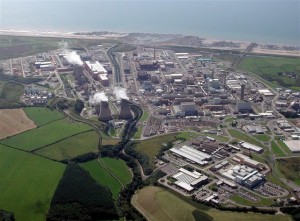
Among the findings, sea spray and marine aerosols created from bubbles forming and popping when the sea is choppy or waves break have increased concentrations of radioactive “actinides.” Actinides are chemically alike radioactive metallic elements and include uranium and plutonium. One actinide infused the spray with 812 times greater concentration of americium 241 than normal amounts of Am-241 in ambient seawater.
“Research demonstrates that the magnitude of the effect is dependent on wind speed and the volume of fine sediment particles (with their adsorbed radioactivity) ejected into the air in sea spray and aerosols,” the report reads.


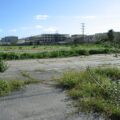









Nuclear power is stupid anyway, but how much stupider to have a nuclear plant on a coast, where earthquakes happen frequently, and then not do jack about it for a YEAR when it blows up due to someone’s incompetence.
Another informative article Michael that inspired me to research further. Please check out the National Library of Medicine’s ‘Toxnet’ pages regarding Uranium Peroxide (UP) and it’s progress after inhalation or ingestion. The article describes it’s solubility, primary effect on gut-mucosa-lung tissues, increased effect on people with acidic urine, emergency treatment for exposure, how people get exposed, etc. (UP) is a known carcinogen that readily targets the kidneys. Not mentioned however is the effect of uranium peroxide in buckyball form or how it might degrade depending on various other isotopes present (mentioned in your ‘Endless Bummer’ article). Take this for what it’s worth, after all, we are in uncharted territories now.
http://toxnet.nlm.nih.gov/cgi-bin/sis/search/r?dbs+hsdb:@term+@rn+19525-15-6
I was looking for info on radiation from Japan and its connection to lung cancer and found your excellent article. The reason I was looking for the connection was that I recently found out that a relative of mine (by marriage) just discovered he has lung cancer that has spread to his liver. He lives in Washington state. He had become ill last spring and at that time, the doctors told him it must be tuberculosis. Now, a year later, they tell him, Oh, we were wrong about TB; this is cancer. Hmmmm. All this time, they could have been using alternative methods of curing cancer if they had been aware that radiation from Japan could have caused it in the first place. They must not have even suspected that his problem could be cancer. If only the officials had let people know of the very real dangers of fallout, this man could maybe have protected himself.
@Chase: Funny you should write this because, following, is another comment on another forum that also looks at ‘cute’ terminology (though, do note Chase, I did not come up with using “buckyballs” as that word has been around long before Fukushima):
@Lennie: I sure hope some of that goo in and around the debris gets rad tested.
@Potrblog: Thank you again for your excellent observations, sampling, testing and useful and possibly lifesaving warnings like this one.
@Margery Brown: Comments like yours keep the (buckyball-free, hopefully) wind in our sails. Thank you.
Buckyballs… sounds cute.
Maybe, if we come up with ‘cute’ names for this kind of stuff people won’t freak out as much. Maybe they’ll listen?
Maybe we could call the other contaminated ocean goo ‘Muckymuck’.
Sounds like something one might order at a fancy restaurant. I’ll have an order of Buckyballs and a side of Muckymuck. Mmmm….
Seriously, most of us know this is just the beginning in the big (long term) scheme of this man made monstrous tragedy. There will be many new descriptors for this crap. But, will the ‘masses’ understand or care? Will the human race still be here in 200 years? I guess that’s just one of the questions at this time.
I hope we learn from this, I pray we can correct it somehow.
Avoid the rain!
Love,
Chase
Jeff Rense Interview with Michael Collins
February 27, 2012: Full-hour show where many topics are covered as one year anniversary of Fukushima meltdowns approaches. Collins describes, drawing on his years as an investigative reporter and journalism judge, how the government and some mainstream media obscure and diffuse danger presented by world’s worst single environmental disaster even as new evidence shows that Los Angeles had the largest cesium-137 deposition after the meltdowns began March 11, 2011.
A family member saw debris on the shore in Oregon above Brookings Harbor, while driving south on the 101 Oregon Coast Highway. He believes it was from Japan. He said that growing up in Oregon he would periodically see things wash ashore from Japan due to how the ocean current flows.
Thanks for sharing your work! I only wish more would listen and learn! I am not surprised to see your findings, but was hoping beyond hope that just maybe it would not get this bad. As usual, shame on lame-stream media!
Has anyone on KPFK interviewed you Michael? Please try sending an audio tape to “Roy of Hollywood” with a note and he might play it, and certainly should.
I will write a piece for the Venice Beachhead and have good reason to believe it will be published.
The Unurban cafe’ is the political cultural hangout of choice, and a great place to connect with people.
You must know all of that, and I must add, I have learned more than I knew from you, can I have shared so far. Decontamination is a priority, especially for my grandchildren. Anything on that?
Bill Mitchell
Great work tonight on Rense. I didn’t hear it all, but caught most of your comments.
We have been fighting the good fight there a long time. In my opinion the best documentation on the web of the events in Japan and the world. Arnie says he likes it. *;-)
Take care,
SP
Michael….This is an amazing and incredible article you have written, and, needless to say,it is terribly frightening! It is absolutely shameful and unbelievable that EPA has packed up a lot of their equipment and announced that everything is o.k….no harm no foul.
We are all just so very lucky to have you, Potrblog and the others who have been contributing to this website!!! You may very well be the only folks standing between all of us and and the “gift” from Fukishima….the one that keeps on giving.
And, most wonderful of all, Michael, is your ability to write (understandably)about the science of what is happening to all of us. I predict that it will all make first a book, and then an Academy-award movie some day. Please keep your HEPA filter going 24-7.
Well done Michael – a fine piece, very fine, with lots of important information and dates.
Most people get angry at me when I mention the R word (radiation). I’m going to send them this piece to brighten up their day.
QChad, I would think about hiking for awhile, or something else. It’s better than risking your very precious life. I know it is a loss, and maybe you can get hooked on another release and spiritual path. All of life is changing in every area, and we are all going to have to make adjustments, even beyond the fallout problems.
well, considering the boat is my only home i almost wish i did not read this
feel like nothing can be done
no one will even speak about it
the biggest question:
do i stop surfing – the only spiritual getaway i have in life!
Very good reporting on this. Thank you!
Another well written powerful expose from MC. This is THE bad bad accident you drive by and better look @.
READ the LA Weekly news feature What’s in Pepper Spray? In California, the toxin TCE
Hi Lady!!! Good to hear from you. Our webmaster 😉 has fixed the problem. Hugs!
Excellent. Thank you once again Michael for your comprehensive and informative work.
Very good work, just one problem…Your paypal button is not working…
Things don’t get no better, they just keep on getting worse.
Many thanks for providing this is very important information. Guess I am going to have to get serious about moving off of the CA coast. I live less than a mile from the Pacific Ocean. This information makes me believe that my HEPA filters, washing my vegetables in bentonite clay and other measures are not nearly enough protection.
Really great information that should encourage others to find out more about what is really happening on the West Coast of the USA…
I suggest you provide a button or link for:
1. Folks to help you collect data in different locations!
2. Folks that want to learn how to collect data.
3. Folks that want to share a detector but cannot afford to “own” one.
Sixteen blocks from the beach is where I live. This puts a new light on coastal living. I haven’t walked the beach in months, mainly after March 11. I am assuming the Inspector won’t be strong enough to measure the buckeye balls? Time is coming where wearing respirators may be the norm. But not after many are convinced of the associated death rates.
Excellent article. Informative, with far-reaching implications. An insidious tide of radioactive pollution is threatening the coastal areas of North America. I won’t be able to visit the beach areas of Southern California without thinking about this new risk. Thank you, Michael, for your excellent research, and bringing this to our attention.